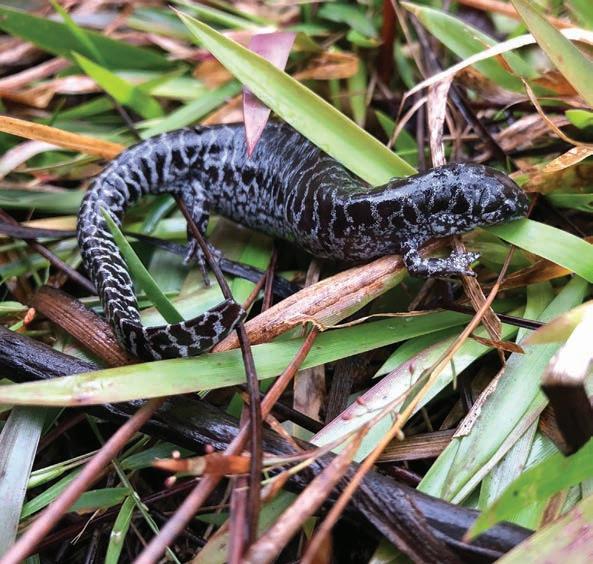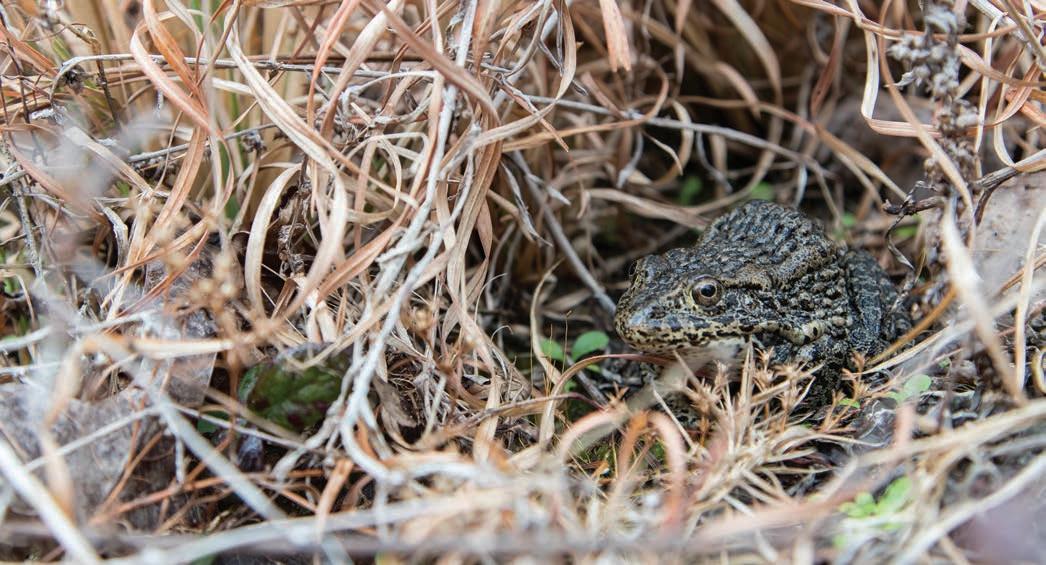
9 minute read
Wetland Restoration
Pond 53 on Eglin Air Force Base during restoration. WEST team members are cutting and removing woody shrubs. Photo by Nicole Barys.

Advertisement
By Jessica Sandoval and Charlie Abeles, The Longleaf Alliance
Wetland Restoration:
A Tool for Creating Diverse, Resilient Lands

The past year presented us with numerous challenges and obstacles, including a record-breaking Atlantic hurricane season with 30 named storms and five major hurricanes. As we experience more unpredictable and severe weather, it becomes increasingly important to consider our forests’ resiliency. As a native coastal species, properly managed longleaf pine often has a higher tolerance to. often has a higher tolerance to severe weather (such as wind and droughts) than other southern pines. Furthermore, there are many significant natural communities embedded within the longleaf ecosystem that improve the resiliency of our communities and their ability to withstand and recover quickly from these threats. Wetlands, in particular, provide essential ecosystem services in the face of climate change and ecological challenges. Why Wetlands?
Wetlands act as a storm surge buffer and sink for flood storage. When large rain events occur, like hurricanes making landfall, wetlands take the brunt of the impact and offer protection to inland resources. Nutrient and pollution inputs from agricultural or urban runoff are filtered or stored by the wetlands, playing an important role in water quality maintenance. On top of these functions, wetlands have a high intrinsic value; if managed properly, they will provide high-quality habitat to numerous wildlife species, including many rare plants and animals. These ecosystems also provide opportunities for recreation that many people utilize and want to see protected. All of this to say, there are many important benefits from continuing to protect, maintain, and restore our wetlands.

Embedded wetlands are integral to the longleaf pine landscape, supporting important plant and wildlife species. Photo by Lisa Lord.
In the Southeast, fire-maintained wetlands are critical habitats for many species of greatest conservation need. Degradation of these habitats from inappropriate fire regimes is sometimes the primary reason for population declines of wildlife species. Fire exclusion alters wetland tree canopy closure, shrub density, and litter accumulation resulting in impacts to vegetation composition, wetland productivity, solar radiation, water temperature, water chemistry, hydrology, and nutrient cycling. Addressing the threat of succession in wetland habitats can have an acute, positive effect on declining wildlife populations.
Restoring Fire
Reintroduction of fire into areas that have been fire-suppressed is a challenge. Land managers and landowners in the Southeast have successfully used prescribed burns to maintain upland habitats, but embedded wetlands are often neglected during implementation. This is often the result of dormant season burning—a time when fire behavior may be more manageable but also when seasonal wetlands are more likely to be holding water. Fires implemented at these times burn up to the saturated boundaries of wetlands but often do not carry through them. Historically, natural fires caused by lightning strikes occurred during transitional periods under conditions allowing for fire to reduce woody competition in wetlands. Ideally, these ephemeral wetlands would have an open canopy and plenty of sunlight reaching the basin to encourage herbaceous growth.
On the other hand, in a fire-suppressed wetland, a closed canopy and a dense mid-story of woody species can shade out the understory and eliminate much of the native ground cover. Increased leaf litter and canopy closure from woody encroachment may change water composition (e.g., pH, dissolved oxygen) within the wetland. Evapotranspiration rates may be influenced by midstory overgrowth resulting in shorter hydroperiods. These changes in water quality and hydrology may negatively impact native plant assemblages and wildlife.
Additionally, the accumulation of litter and duff is an obstacle for prescribed burn managers and landowners. If we base our strategies on natural fire regimes, the ideal time to burn would

Pond 53 on Eglin Air Force Base after mechanical treatment by the WEST Team. Photo by Kaiden Spurlock.
Reticulated flatwoods salamander (Ambystoma bishopi). Photo by Jessica Sandoval.
tem Partnership (GCPEP) landscape.

be when wetlands are dry during the lightning season (late spring or summer). However, dormant season burns may be necessary to reduce fuel loads before growing season burns are considered a safe option by land managers. As they try to navigate crew safety, fire behavior, and smoke management concerns, it can be challenging to restore wetlands with fire alone.
Removing mid-story shrubs and trees prior to burns can drastically improve restoration efforts allowing prescribed fire to peel away at duff layers accumulated during periods without fire. This process involves using chainsaws and brush cutters to cut down trees and shrubs, remove them from the wetland basin, and treat the cut stumps with herbicides. This biomass is then strategically placed on the outskirts of the wetland so the debris will burn and provide fuel during the next prescribed fire. When followed up with growing season burns, this technique creates suitable habitat for rare ground cover species, including many carnivorous plants. Reducing woody vegetation may also result in a longer hydroperiod, a limiting factor for many pond breeding amphibians. This is one of the methods The Longleaf Alliance uses in the Gulf Coastal Plains to restore seasonal wetland habitat.
Resilient and Diverse Partnerships
The resiliency and diversity of longleaf pine ecosystems make it unique and are its most essential aspects. As stewards of the land, we should focus on the maintenance and restoration of habitats and ecosystems that provide crucial services to our communities, especially the often-overlooked wetlands. This will require more growing season fire and ongoing hand and mechanical restoration efforts by partners in the longleaf range. Building and maintaining partnerships with diverse groups is crucial to restore longleaf ecosystem resiliency on both public and private lands. The Longleaf Alliance, in collaboration with its many partners, looks forward to continuing this work in
Public Land Partnerships: Reticulated Flatwoods Salamander
Like many amphibian species, the federally endangered reticulated flatwoods salamander (Ambystoma bishopi or RFS for short) depends on well-maintained, seasonally inundated wetlands within the longleaf ecosystem. Extirpated from much of its historical range, they are currently found in the western panhandle of Florida and southern Georgia, with two of the last strongholds located on Eglin Air Force Base and Escribano Point Wildlife Management Area.
The Longleaf Alliance (LLA) is involved in a recovery effort supported by the Department of Defense (DoD), the DoD Readiness and Environmental Protection Integration Program, the National Fish and Wildlife Foundation, the U.S. Fish and Wildlife Service, and the Florida Fish and Wildlife Conservation Commission. The LLA employs teams dedicated to yearround wetland restoration and prescribed burning; the Ecosystem Support Team (EST), the Wetland Ecosystem Support Team (WEST), and the AMBBIS (short for Ambystoma bishopi) Seasonal Restoration Team have assisted with vegetation removal on several sites within the Gulf Coastal Plain Ecosysyears to come.
In addition, the AMBBIS Team is tasked with running the head-starting program to augment the declining RFS population. Several field crews have been instrumental in reaching restoration goals. Our partners at Eglin Air Force Base and Florida Fish and Wildlife Conservation Commission are also applying progressive land management techniques in wetlands where hand restoration is not feasible, mainly the use of heavy equipment to remove encroaching species and to scrape up the accumulated duff layer.

Gopher frog (Lithobates capito). Photo by Brady Beck.

Engaging Private Landowners: Gopher Frogs in South Carolina By Lisa Lord, The Longleaf Alliance
Much of the high-quality habitat for rare species is on private land because of outstanding stewardship. Landowners continue to have an important role in protecting rare species, including those that go largely unnoticed, like the gopher frog. This is why The Longleaf Alliance, Dr. Stacey Lance, a research scientist at UGA’s Savannah River Ecology Laboratory, and the U.S. Fish and Wildlife Service Coastal Program are working hand in hand with landowners on a new project. The team’s efforts involve surveying private lands to better understand the species status while looking for reintroduction opportunities. Frog searching includes using acoustic loggers, visual searches for egg masses, and collecting water samples for DNA analysis.
The team is also working with landowners to improve their habitat. Gopher frogs are associated with a suite of other amphibians, and improving potential gopher frog habitat creates a more resilient landscape that benefits the species associated with the same habitat. Many landowners involved in this project are now enthusiastic about the benefits their improved management offers to wildlife on their land, even those wildlife to which they were initially unaware.
The potential for where gopher frogs could be hiding is vast. Within the historical range and known remaining suitable habitat, there are hundreds of wetlands to explore. The team is grappling with envisioning a site’s history and how the past impacted (or is still impacting) the presence or absence of the species. Even if the habitat is suitable today, prior management or land uses may have eliminated the frogs who remain unable to recolonize.
Despite the challenges, LLA, SREL, and the USFWS have high hopes for this project and what it could mean for species recovery. It exemplifies how public and private partners and landowners can work together to conserve and create resilient habitat for priority species. References Association of State Floodplain Managers (ASFPM). 2008.
Natural and Beneficial Floodplain Functions: Floodplain
Management―More Than Flood Loss Reduction.
Madison, WI: ASFPM. Battle, J., and S. W. Golladay. 2003. Prescribed fire’s impact on water quality of depressional wetlands in southwestern
Georgia. American Midland Naturalist 150: 15-25. Clark, K.E., E. Chin, M.N. Peterson, K. Lackstrom, K. Dow,
M. Foster, and F. Cubbage. 2018. Evaluating climate change planning for longleaf pine ecosystems in the
Southeast United States. Journal of the Southeastern
Association of Fish and Wildlife Agencies 5:160–168 Gorman, T. A., C. A. Hass, and D. C. Bishop. 2009. Factors related to occupancy of breeding wetlands by flatwoods salamander larvae. Wetlands 29: 323-329. Kirkman, L. K. 1995. Impacts of fire and hydrological regimes on vegetation in depression wetlands of southeastern USA.
Pages 10-20 in Susan I. Cerulean and R. Todd Engstrom, eds. Fire in wetlands: a management perspective. Proceedings of the Tall Timbers Fire Ecology Conference, No. 19.
Tall Timbers Research Station, Tallahassee, FL. Klaus, J. M., and R. F. Noss. 2016. Specialist and generalist amphibians respond to wetland restoration treatments.
Journal of Wildlife Management 80: 1106-1119. Pilliod, D. S., R. B. Bury, E. J. Hyde, C. A. Pearl, and P. S.
Corn. 2003. Fire and amphibians in North America. For est Ecology and Management 178: 163-181.










